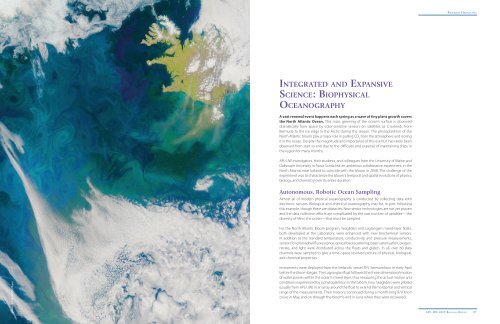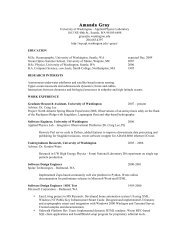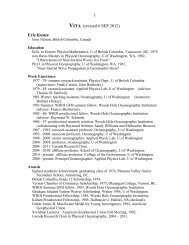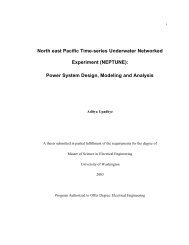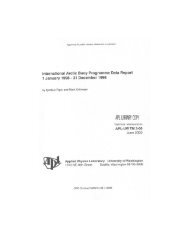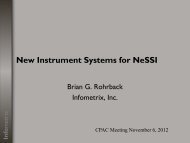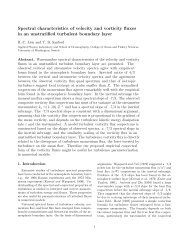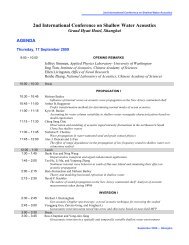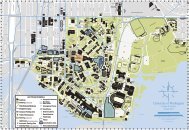2009 Biennial (PDF, 12 MB) - Applied Physics Laboratory-University ...
2009 Biennial (PDF, 12 MB) - Applied Physics Laboratory-University ...
2009 Biennial (PDF, 12 MB) - Applied Physics Laboratory-University ...
You also want an ePaper? Increase the reach of your titles
YUMPU automatically turns print PDFs into web optimized ePapers that Google loves.
photo: NASA, MODIS/Aqua<br />
integrated and exPanSive<br />
Science: bioPHySical<br />
oceanograPHy<br />
A vast renewal event happens each spring as a wave of tiny plant growth covers<br />
the North Atlantic Ocean. This mass greening of the ocean’s surface is observed<br />
dramatically from space by color-sensitive sensors on satellites as it extends from<br />
Bermuda to the ice edge in the Arctic during the season. The phytoplankton of the<br />
North Atlantic bloom play a major role in pulling CO 2 from the atmosphere and storing<br />
it in the ocean. Despite the magnitude and importance of this event, it has rarely been<br />
observed from start to end due to the difficulty and expense of maintaining ships in<br />
the region for many months.<br />
APL-UW investigators, their students, and colleagues from the <strong>University</strong> of Maine and<br />
Dalhousie <strong>University</strong> in Nova Scotia led an ambitious collaborative experiment in the<br />
North Atlantic near Iceland to coincide with the bloom in 2008. The challenge of the<br />
experiment was to characterize the bloom’s temporal and spatial evolutions of physics,<br />
biology, and chemistry over its entire duration.<br />
Autonomous, Robotic Ocean Sampling<br />
Almost all of modern physical oceanography is conducted by collecting data with<br />
electronic sensors. Biological and chemical oceanography may be, in part, following<br />
this example, though there are obstacles. New sensor technologies are not yet proven<br />
and the data collection efforts are complicated by the vast number of variables—the<br />
diversity of life in the ocean —that must be sampled.<br />
For the North Atlantic Bloom program, Seagliders and Lagrangian mixed-layer floats,<br />
both developed at the <strong>Laboratory</strong>, were enhanced with new biochemical sensors.<br />
In addition to the standard temperature, conductivity, and pressure measurements,<br />
sensors for chlorophyll fluorescence, optical backscattering, beam attenuation, oxygen,<br />
nitrate, and light were distributed across the floats and gliders. In all, over 60 data<br />
channels were sampled to give a time–space resolved picture of physical, biological,<br />
and chemical properties.<br />
Instruments were deployed from the Icelandic vessel R/V Saemundsson in early April<br />
before the bloom began. The Lagrangian float followed the three-dimensional motion<br />
of water parcels within the ocean’s mixed layer, thus measuring the actual motion and<br />
conditions experienced by a phytoplankton in the bloom. Four Seagliders were piloted<br />
(usually from APL-UW) in an array around the float to extend the horizontal and vertical<br />
range of the measurements. Their missions continued during a month-long R/V Knorr<br />
cruise in May, and on through the bloom’s end in June when they were recovered.<br />
ReseARCh highLights<br />
26 APL–UW <strong>2009</strong> BienniAL RePoRt APL–UW <strong>2009</strong> BienniAL RePoRt 27


